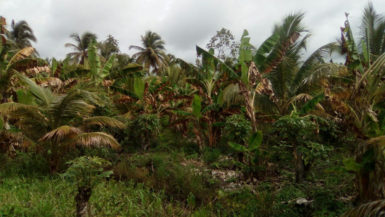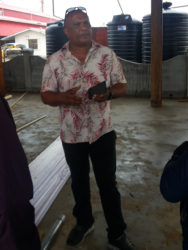In the Pomeroon River, there continues to be an awareness that the coconut market can provide a lucrative entrepreneurial option, so much so that Pomeroon landowners, who had just a few years ago had turned their backs on the land and headed for the gold fields, are making the trek back.
Newly elected President of the Essequibo Chamber of Commerce, merchant and hotelier, Deleep Singh believes that coconuts may help the Pomeroon drift in the direction of a more stable economy. It will, however, take some time.
There may be ‘money in coconuts’ but in this instance making money requires serious investment. This newspaper’s conversations with farmers on the Essequibo Coast and the Pomeroon River just over a week ago led to some revelations about the coconut industry.
With high coconut prices now pushing Pomeroon landowners in the direction of pressing long-neglected lands into service, proper preparation of a single acre of land for coconut cultivation could cost between $250,000 and $300,000. Those costs would cover the hiring of equipment – excavator and pontoon – to undertake the erection of five-foot high mud ‘walls’ to keep the floodwaters at bay and the acquisition of planting material. The coconut groves can range in size from a single acre to a few hundred acres.

At Grant Beach Profitt in the Pomeroon River, Vilma Da Silva’s Henville Farms is exporting coconut water to Trinidad and Tobago. She already has 35 acres under coconut cultivation but she is encouraged by the market and is in the process of bringing a further 400 acres under cultivation. Hers is not exactly a small operation. At $230 per litre the venture is profitable. Her workers could extract water from between 10,000 and 16,000 coconuts daily. The product is volatile and the process must take place in a carefully controlled environment. Afterwards the coconut water must immediately be stored at a temperature that is 4 degrees below zero. A refrigerated truck transports the commodity to Georgetown to be shipped to Trinidad.
During the process of preparation each coconut is washed and examined and placed in a storage room. The water is strained and put into bottles imported from Trinidad.
Everything is done manually and once a consignment leaves Guyana it goes almost directly to the supermarkets in Trinidad.
Henville Farms currently supplies bulk coconut water to two buyers in Trinidad and to Sterling Products in Guyana. In a few weeks, Henville Pure Coconut Water produced and bottled in the Pomeroon River will be available on the local market.
Hrenville’s approximately 24 staff include pickers, cutters and quality controllers. Vulnerability to spoilage means that particular attention must be paid to quality control. Workers must be trained.


Essequibo Coast businessman Ramesh Ramotar already has 200 acres of coconuts under cultivation at New Providence in the Pomeroon River. He too is expanding cultivation to 500 acres, in preparation for his bottling plant which is currently being set up. His plans include a method of preparation that allows the coconut water to be exported inside the shell. It requires shaving away most of outer shell in order to reduce the weight of the coconut and enable the consumer to access the water more easily. The factory, situated at Land of Plenty, could be ready in two weeks. It is a multi-million-dollar investment that requires ISO certification and which, Ramotar says, is targeting both the regional and European markets. Until the product comes on stream, the operation is being overlooked by 12 persons.
Wendell Daniel operates a 55-acre coconut grove at Unity in the Pomeroon River. Da Silva is one of his key customers. His coconuts also find their way to vendors’ stands in the city.
The vendors travel to Charity by truck and the coconuts arrive from the Pomeroon River by boat. When this newspaper visited, the purchase price at Charity was $50 per coconut. The vendors who were hiring boats at Charity and journeying to the farms on the Pomeroon River were buying the coconuts at $40 each.
Grant is also cultivating plantain, banana, avocado and other cash crops for sale at Charity and elsewhere.
The Red Palm Mite now poses a serious threat to production in the Pomeroon. The farmers estimate that the production of coconuts has dropped from around 30 per thrush per month to as few as 5 to 10 coconuts. Earnings have dropped and they are working with the NAREI in an effort to combat the disease. The treatment involves drilling holes in the trunks of the coconut trees and injecting them with Monocrotophos, an insecticide used to control common mites, ticks and spiders. Afterwards, the farmers must wait 45 days before coconuts can be harvested.
Figures secured from the New Guyana Marketing Corporation indicate that coconut exports have been a significant money earner in recent years. In 2012, exports totaling 8,630.27 metric tonnes realized US$2,579,378 while in 2013 exports totaling 10,213.36 metric tonnes realized earnings in excess of US$3 million. In 2014, export volumes climbed to 11,165 metric tonnes and fetched US$4,378,498.
Unverified figures for 2015 indicate that export volumes and earnings fell below the previous years, a circumstance which the farmers attribute mostly to the ravages of the Red Palm Mite. Still, in an economy where options are limited they appear determined to press on.




